-
 Bitcoin
Bitcoin $117900
0.31% -
 Ethereum
Ethereum $3766
0.28% -
 XRP
XRP $3.176
-0.31% -
 Tether USDt
Tether USDt $1.000
0.00% -
 BNB
BNB $795.6
1.51% -
 Solana
Solana $186.8
-1.09% -
 USDC
USDC $0.9999
-0.01% -
 Dogecoin
Dogecoin $0.2353
-1.33% -
 TRON
TRON $0.3226
1.49% -
 Cardano
Cardano $0.8172
-1.08% -
 Sui
Sui $4.178
3.06% -
 Hyperliquid
Hyperliquid $43.05
-3.39% -
 Stellar
Stellar $0.4367
-0.57% -
 Chainlink
Chainlink $18.62
1.47% -
 Hedera
Hedera $0.2828
6.63% -
 Bitcoin Cash
Bitcoin Cash $584.7
5.65% -
 Avalanche
Avalanche $24.81
2.53% -
 Litecoin
Litecoin $112.8
-0.88% -
 UNUS SED LEO
UNUS SED LEO $8.975
-0.08% -
 Shiba Inu
Shiba Inu $0.00001395
-1.07% -
 Toncoin
Toncoin $3.285
-1.05% -
 Ethena USDe
Ethena USDe $1.001
0.01% -
 Polkadot
Polkadot $4.123
0.76% -
 Uniswap
Uniswap $10.49
-0.18% -
 Monero
Monero $326.5
0.14% -
 Dai
Dai $0.9999
-0.02% -
 Bitget Token
Bitget Token $4.576
0.34% -
 Pepe
Pepe $0.00001247
-1.55% -
 Cronos
Cronos $0.1400
3.77% -
 Aave
Aave $295.1
-0.73%
What is the significance of the WR indicator hitting the top and falling back? When to enter the oversold area?
The Williams %R indicator signals overbought at 0 and oversold at -80, guiding traders on potential price reversals in cryptocurrency markets.
Jun 09, 2025 at 09:57 pm
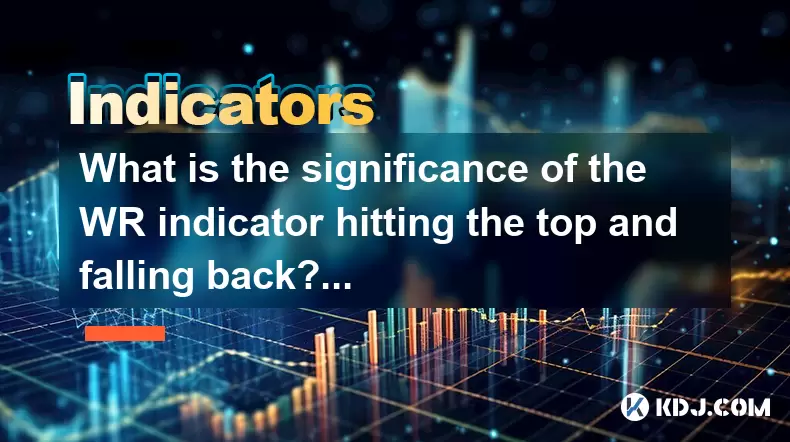
The Williams %R (WR) indicator is a momentum indicator used in technical analysis to identify overbought and oversold conditions in the market. It is particularly popular among cryptocurrency traders for its ability to signal potential reversals in price trends. The significance of the WR indicator hitting the top and falling back, as well as the optimal timing for entering the oversold area, are crucial aspects for traders to understand and utilize effectively.
Understanding the Williams %R Indicator
The Williams %R indicator, developed by Larry Williams, measures the level of the close relative to the high-low range over a given period, typically 14 days. The formula for the WR is:
[ \text{WR} = \frac{\text{Highest High} - \text{Close}}{\text{Highest High} - \text{Lowest Low}} \times -100 ]
The resulting value ranges from 0 to -100. A reading of 0 indicates that the closing price was at the highest point of the period, while a reading of -100 indicates the closing price was at the lowest point. The indicator is typically plotted as a line on a chart, and its position helps traders gauge market momentum.
Significance of WR Hitting the Top and Falling Back
When the WR indicator hits the top (i.e., reaches 0), it suggests that the market is in an overbought condition. This means that the asset's price has risen to a level where it is considered too high and may be due for a correction or reversal. Conversely, when the WR indicator falls back from the top, it indicates that the price has started to decline from its peak, potentially signaling the beginning of a bearish trend or a correction.
Traders often look for this fall-back as a confirmation that the overbought condition is resolving. A significant drop from the top, especially if accompanied by other bearish indicators, can be a strong signal to consider selling or shorting the asset. However, it's essential to wait for confirmation from other technical indicators or price action to avoid false signals.
Identifying the Oversold Area
The oversold area is identified when the WR indicator falls to or below -80. This level suggests that the market has been pushed down to a point where it is considered too low and may be due for a rebound. Traders look for the WR to enter this zone as a potential buying opportunity, anticipating that the price will soon recover.
When to Enter the Oversold Area
Entering the oversold area can be a profitable strategy, but timing is crucial. Here are some guidelines on when to enter the oversold area:
Wait for Confirmation: Before entering a position, it's advisable to wait for additional confirmation from other technical indicators, such as the Relative Strength Index (RSI) or Moving Average Convergence Divergence (MACD). If these indicators also suggest that the market is oversold, the signal becomes stronger.
Look for Divergence: Divergence occurs when the price action and the WR indicator move in opposite directions. If the price is making new lows, but the WR indicator is not, this could be a sign of a potential reversal. This divergence can be a strong signal to enter the oversold area.
Monitor Price Action: Pay close attention to candlestick patterns and price movements. Bullish reversal patterns, such as hammer or doji candles, can indicate that the market is ready to turn around from the oversold condition.
Use Support Levels: Identify key support levels on the chart. If the WR indicator enters the oversold area near a strong support level, it increases the likelihood of a price rebound, making it a more favorable entry point.
Practical Example of Using the WR Indicator
To illustrate how to use the WR indicator effectively, let's consider a hypothetical scenario with Bitcoin (BTC). Suppose the WR indicator for BTC has just hit the top (0) and is now falling back. Here's how a trader might proceed:
Monitor the Fall: Watch as the WR indicator falls from 0. If it drops quickly and significantly, it could indicate a strong bearish momentum.
Look for Oversold Signals: Wait for the WR indicator to reach or fall below -80. This signals that BTC is now in the oversold area.
Confirm with Other Indicators: Check other indicators like the RSI. If the RSI is also in the oversold territory (typically below 30), it strengthens the case for a potential reversal.
Analyze Price Action: Look for bullish reversal patterns on the candlestick chart. If a hammer or doji candle appears near the oversold area, it could be a good entry signal.
Enter the Position: Once all these conditions are met, consider entering a long position on BTC, anticipating a price rebound.
Detailed Steps for Entering a Position
When it comes to actually entering a position based on the WR indicator hitting the top and falling back into the oversold area, here are the detailed steps a trader might follow:
Open the Trading Platform: Launch your preferred trading platform, such as Binance or Coinbase Pro.
Select the Asset: Choose the cryptocurrency you want to trade, such as Bitcoin (BTC).
Apply the WR Indicator: Add the WR indicator to your chart. Most platforms allow you to customize the period, typically setting it to 14 days.
Monitor the WR Indicator: Keep an eye on the WR indicator as it moves. When it reaches 0 and starts falling, take note of the price level.
Identify the Oversold Area: Wait for the WR indicator to fall to or below -80. This indicates that the asset is now in the oversold area.
Confirm with Other Indicators: Check other technical indicators like RSI or MACD to confirm the oversold condition.
Analyze Price Action: Look for bullish reversal patterns on the candlestick chart. Patterns like hammer or doji candles can signal a potential reversal.
Set Entry Order: Once you have confirmed the oversold condition and identified a bullish reversal pattern, set an entry order for the asset. You can use a market order for immediate execution or a limit order to enter at a specific price.
Set Stop-Loss and Take-Profit Levels: To manage risk, set a stop-loss order below the recent low and a take-profit order at a reasonable target based on resistance levels or other technical analysis.
Frequently Asked Questions
Q: Can the WR indicator be used effectively on different time frames?
A: Yes, the WR indicator can be applied to various time frames, from intraday charts to weekly charts. However, the effectiveness of the indicator may vary depending on the time frame. Shorter time frames may produce more false signals, while longer time frames might offer more reliable signals but with fewer trading opportunities.
Q: How does the WR indicator compare to other momentum indicators like the RSI?
A: The WR indicator and the RSI both measure momentum and overbought/oversold conditions, but they differ in their calculation and interpretation. The WR focuses on the closing price relative to the high-low range, while the RSI considers the average gain and loss over a period. Some traders use both indicators together to confirm signals and reduce the likelihood of false positives.
Q: Is it necessary to use other technical indicators alongside the WR indicator?
A: While the WR indicator can be a powerful tool on its own, using it in conjunction with other technical indicators can enhance its effectiveness. Indicators like the RSI, MACD, and moving averages can provide additional confirmation and help traders make more informed decisions.
Q: What are the potential risks of relying solely on the WR indicator for trading decisions?
A: Relying solely on the WR indicator can lead to false signals and potential losses. The indicator is sensitive to price movements and can sometimes produce whipsaws, especially in volatile markets. It's crucial to use other forms of analysis, such as price action and additional technical indicators, to validate signals and manage risk effectively.
Disclaimer:info@kdj.com
The information provided is not trading advice. kdj.com does not assume any responsibility for any investments made based on the information provided in this article. Cryptocurrencies are highly volatile and it is highly recommended that you invest with caution after thorough research!
If you believe that the content used on this website infringes your copyright, please contact us immediately (info@kdj.com) and we will delete it promptly.
- Cryptos to Watch in 2025: Punisher Coin, Chainlink, and the Altcoin Arena
- 2025-07-27 18:30:13
- Bitcoin, Altcoins, Rebound: Navigating the Crypto Comeback Trail
- 2025-07-27 18:30:13
- Ethereum, Bitcoin, and Altcoins: A Shift in Crypto Tides?
- 2025-07-27 19:10:13
- Windtree Therapeutics' Bold BNB Strategy: A $520 Million Crypto Play
- 2025-07-27 19:10:13
- Solana, Staking, and Unilabs: What's the Buzz in the Crypto Space?
- 2025-07-27 16:50:13
- VeChain, HBAR, Remittix: Navigating the Crypto Landscape in 2025
- 2025-07-27 17:10:12
Related knowledge
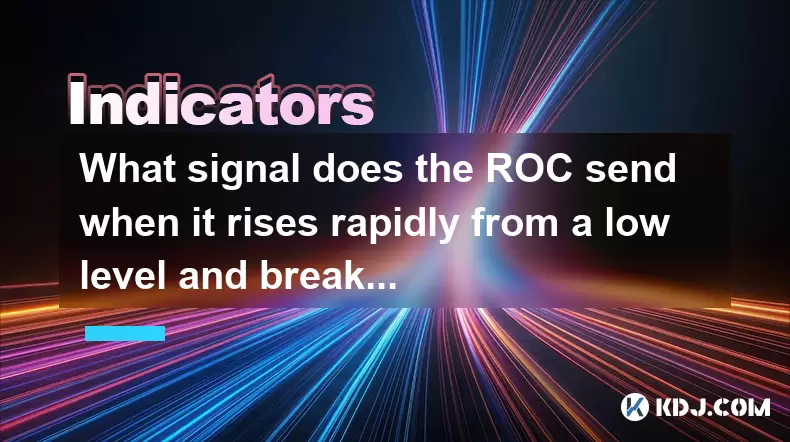
What signal does the ROC send when it rises rapidly from a low level and breaks through the zero axis?
Jul 27,2025 at 10:15am
Understanding the Rate of Change (ROC) IndicatorThe Rate of Change (ROC) is a momentum-based oscillator used in technical analysis to measure the perc...
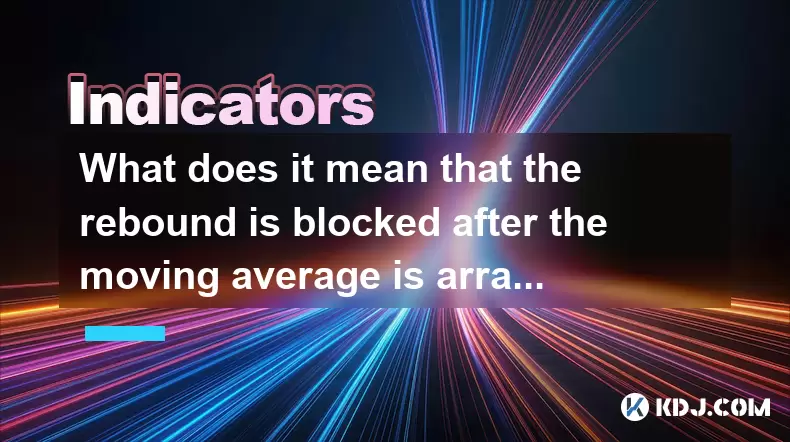
What does it mean that the rebound is blocked after the moving average is arranged in a short position for the first time?
Jul 26,2025 at 10:51am
Understanding the Short-Term Moving Average ConfigurationWhen traders refer to a 'short position arrangement' in moving averages, they are describing ...
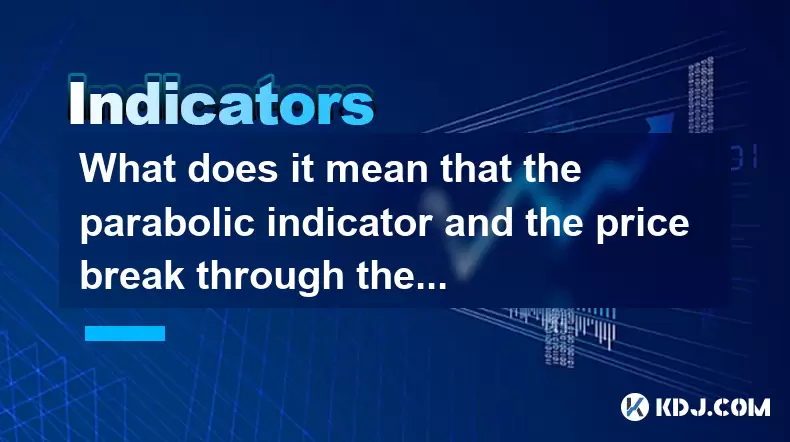
What does it mean that the parabolic indicator and the price break through the previous high at the same time?
Jul 26,2025 at 07:22pm
Understanding the Parabolic Indicator (SAR)The Parabolic SAR (Stop and Reverse) is a technical analysis tool developed by J. Welles Wilder to identify...
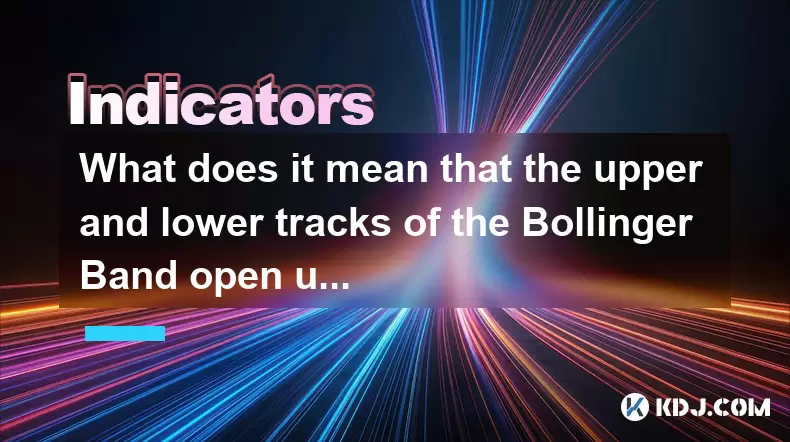
What does it mean that the upper and lower tracks of the Bollinger Band open upward at the same time?
Jul 27,2025 at 02:49pm
Understanding the Bollinger Band StructureThe Bollinger Band is a widely used technical analysis tool developed by John Bollinger. It consists of thre...
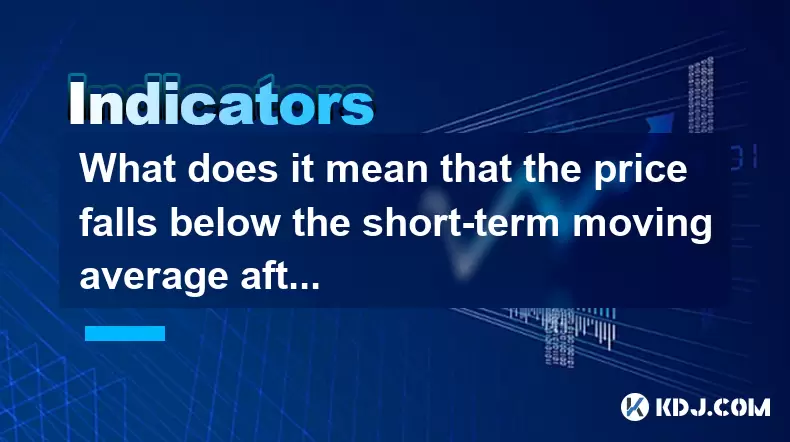
What does it mean that the price falls below the short-term moving average after the RSI top divergence?
Jul 26,2025 at 11:01pm
Understanding RSI Top Divergence in Cryptocurrency TradingThe Relative Strength Index (RSI) is a momentum oscillator widely used in cryptocurrency tra...
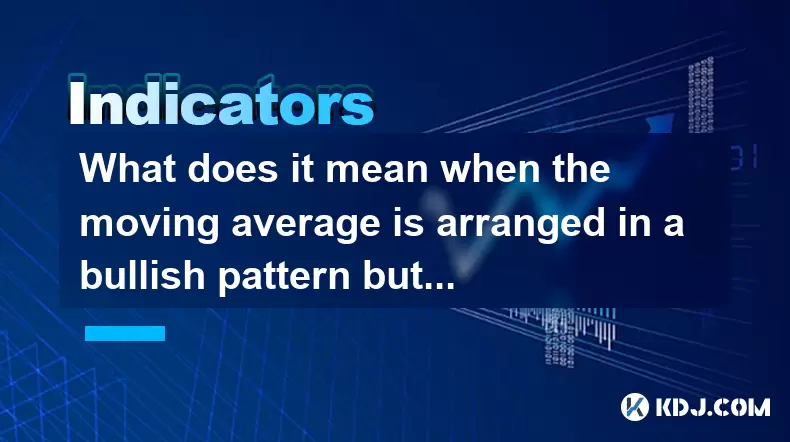
What does it mean when the moving average is arranged in a bullish pattern but the MACD bar is shortened?
Jul 27,2025 at 06:07am
Understanding the Bullish Moving Average PatternWhen traders observe a bullish moving average pattern, they typically refer to a configuration where s...

What signal does the ROC send when it rises rapidly from a low level and breaks through the zero axis?
Jul 27,2025 at 10:15am
Understanding the Rate of Change (ROC) IndicatorThe Rate of Change (ROC) is a momentum-based oscillator used in technical analysis to measure the perc...

What does it mean that the rebound is blocked after the moving average is arranged in a short position for the first time?
Jul 26,2025 at 10:51am
Understanding the Short-Term Moving Average ConfigurationWhen traders refer to a 'short position arrangement' in moving averages, they are describing ...

What does it mean that the parabolic indicator and the price break through the previous high at the same time?
Jul 26,2025 at 07:22pm
Understanding the Parabolic Indicator (SAR)The Parabolic SAR (Stop and Reverse) is a technical analysis tool developed by J. Welles Wilder to identify...

What does it mean that the upper and lower tracks of the Bollinger Band open upward at the same time?
Jul 27,2025 at 02:49pm
Understanding the Bollinger Band StructureThe Bollinger Band is a widely used technical analysis tool developed by John Bollinger. It consists of thre...

What does it mean that the price falls below the short-term moving average after the RSI top divergence?
Jul 26,2025 at 11:01pm
Understanding RSI Top Divergence in Cryptocurrency TradingThe Relative Strength Index (RSI) is a momentum oscillator widely used in cryptocurrency tra...

What does it mean when the moving average is arranged in a bullish pattern but the MACD bar is shortened?
Jul 27,2025 at 06:07am
Understanding the Bullish Moving Average PatternWhen traders observe a bullish moving average pattern, they typically refer to a configuration where s...
See all articles

























































































